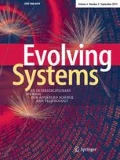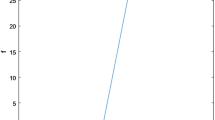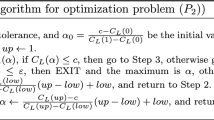Abstract
During the recent decades, option pricing became an important topic in computational finance. The main issue is to obtain a model of option prices that reflects price movements observed in the real world. In this paper we address option pricing using an evolving fuzzy system model and Brazilian interest rate options data. Evolving models are particularly appropriate because they gradually develops the model structure and parameters from a stream of data. Therefore, evolving fuzzy models provide a higher level of system adaptation and learns the system dynamics continuously, an essential attribute in pricing options estimation. In particular, we emphasize the use of the evolving participatory learning methods. The participatory evolving models considered in this paper are compared against the traditional Black’s closed-form formula, artificial neural networks structures, and alternative evolving fuzzy system approaches reported in the literature. Actual daily data used in the experiments cover the period from January 2003 to June 2008. We measure forecast performance of all models and report the statistical tests done for the competing forecast models. The results show that the participatory evolving fuzzy system modeling approach is effective to estimate prices of fixed income options.

Similar content being viewed by others
Notes
The Black model (Black 1976) considered in this work follows the Black–Scholes model exactly, except for the assumption that the spot price is a log-normal process which is replaced by the assumption that the forward price at maturity of the option is log-normally distributed. The derivation is identical and the final formula is the same except that the spot price is replaced by the forward price. The forward price represents the undiscounted expected future value.
Brazilian banks usually express their costs of funding in percentage of the published CDI terms, and it can be said that CDI is the relevant cost of opportunity for Brazilian banks.
The data was obtained with BM&FBOVESPA.
The best model, in terms of accuracy, is the one that shown TIC index close to zero.
The p values are shown in parenthesis.
References
Abonyi J, Babuska R, Szeifert F (2002) Modified Gath-Geva fuzzy clustering for identification of Takagi-Sugeno fuzzy models. IEEE Trans Syst Man Cybern Part B 32(5):612–621
Almeida CIR, Vicente JV (2006) Pricing and hedging brazilian fixed income options. In: Proceedings of the 6th Brazilian financial meeting, Vitória, Brazil
Angelov P (2002) Evolving rule-based models: a tool for design of flexible adaptive systems. Springer, Heidelberg, ISBN:3-7908-1457-1
Angelov P, Filev D (2004) An approach to on-line identification of evolving Takagi-Sugeno fuzzy models. IEEE Trans Syst Man Cybern Part B 34(1):484–498
Angelov P, Filev D (2005) Simpl_eTS: a simplified method for learning evolving Takagi-Sugeno fuzzy models. In: Proceedings of the 2005 international conference on fuzzy systems, FUZZ-IEEE, Reno, USA, pp 1068–1073
Angelov P, Zhou X (2006a) Evolving fuzzy systems from data streams in real-time. In: Proceedings of the international symposium on evolving fuzzy systems, pp 29–35
Angelov P, Zhou X (2006b) Online identification of Takagi-Sugeno fuzzy models DEMO. http://194803445/eTS/
Astrom KJ, Wittenmark B (1994) Adaptive control, 2nd edn. Addison-Wesley Longman Publishing Co., Inc., Boston
Barbedo CHS, Vicente JVM, Lion OMB (2009) Pricing asian interest rate options with a Three-Factor HJM model. Working Paper Series 188. http://www.bcb.gov.br/pec/wps/ingl/wps188.pdf
Black F (1976) The pricing of commodity contracts. J Financ Econ 3:167–179
Black F, Scholes M (1973) The pricing of options and corporate liabilities. J Political Econ 81(3):637–654
Chiu SL (1994) Fuzzy model identification based on cluster estimation. J Intell Fuzzy Syst 2:267–278
Diebold FX, Mariano RS (1995) Comparing predictive accuracy. J Bus Econ Stat 13(3):253–263
Figa-Talamanca G, Guerra ML (2009) Fuzzy option value with stochastic volatility models. In: Proceedings of the 8th international conference on intelligent systems design and applications, Pisa, Italy
Gençay R, Qi M (2001) Pricing and hedging derivative securities with neural networks:Bayesian regularization, early stopping and bagging. IEEE Trans Neural Netw 12(4):726–734
Hastie T, Tibshirani R, Friedman JH (2001) The element of statistical learning: data mining, inference, and prediction, 2nd edn. Springer, New York
Johnson CR (1988) Lectures & adaptive parameter estimation, 1st edn. Prentice-Hall, Upper Saddle River
Junior AF, Greco F, Lauro C, Francisco G, Rosenfeld R, Oliveira R (2003) Application of Hull-White model to Brazilian IDI options. In: Proceedings of the 3th Brazilian financial meeting, Florianópolis, Brazil
Kasabov N, Song Q (2002) DENFIS: dynamic evolving neural-fuzzy inference system and its application for time series prediction. IEEE Trans Fuzzy Syst 10(2):144–154
Kim E, Park M, Kim S, Park M (1998) A transformed input-domain approach to fuzzy modeling. IEEE Trans Fuzzy Syst 6(4):596–604
Lehmann EL (1988) Nonparametric statistical methods based on ranks. Prentice Hall, Englewood Cliffs
Lemos A, Gomide F, Caminhas W (2011) Multivariable gaussian evolving fuzzy modeling system. IEEE Trans Fuzzy Syst 19(1):91–104
Leu Y (2010) A fuzzy time series-based neural network approach to option price forecasting. Lect Notes Comput Sci 5990:360–369. doi:10.1007/978-3-642-12145-6_37
Lima E (2008) Modelo Takagi-Sugeno evolutivo participativo. Master’s thesis, School of Electrical and Computer Engineering, University of Campinas
Lima E, Ballini R, Gomide F (2010a) Dynamic analysis of the participatory learning algorithm. In: Proceedings of the 36th annual convention of the Society for the Study of Artificial Intelligence and Simulation of Behaviour (AISB), Leicester, UK
Lima E, Hell M, Ballini R, Gomide F (2010b) Evolving fuzzy modeling using participatory learning. In: Angelov P, Filev D, Kasabov N (eds) Evolving intelligent systems, chap 4. Wiley-IEEE-Press, NJ, pp 67–86
Liu F (2009) Pricing currency options based on fuzzy techniques. Eur J Oper Res 193(2):530–5402
Ljung L (1999) System identification—theory for the user, 2nd edn. Prentice-Hall, Englewood Cliffs
Ljung L (1999b) System identification: theory for the user. Prentice-Hall, Heidelberg, ISBN:0-13-656695-2
Lughofer ED (2008) FLEXFIS: a robust incremental learning approach for evolving Takagi-Sugeno fuzzy models. IEEE Trans Fuzzy Syst 16(6):1393–1410
Maciel LS, Ballini R (2010) Option pricing using fuzzy and neuro-fuzzy inference systems. In: Proceedings of the 4th CSDA international conference on computational and financial economics, London
Pedrycz W, Gomide F (2007) Fuzzy systems engineering: toward human-centric computing. Wiley Interscience, NJ
Schwarz G (1978) Estimating the dimension of a model. Ann Stat 6(2):461–468
Silva L, Gomide F, Yager RR (2005) Participatory learning in fuzzy clustering. In: The 2005 IEEE international conference on fuzzy systems FUZZ-IEEE, pp 857–861
Wellstead PE, Zarrop MB (1995) Self-tuning systems: control and signal processing, 1st edn. Wiley, New York
Wu H (2005) European option pricing under fuzzy environments. Int J Intell Syst 20(1):89–102
Yager RR (1990) A model of participatory learning. IEEE Trans Syst Man Cybern 20:1229–1234
Yager R, Filev D (1994) Approximate clustering via the mountain method. IEEE Trans Syst Man Cybern 24(8):1279–1284
Yang ZR, Platt MB, Platt HD (1999) Probabilistic neural network in bankruptcy predictions. J Bus Res 44(2):67–74
Young PC (1984) Recursive estimation and time-series analysis. Springer, Berlin
Zurada JM, Foster BP, Ward TJ, Barker PM (1999) Neural networks versus logit regression models for financial distress response variables. J Appl Bus Res 15:21–29
Acknowledgments
This work was supported by the Brazilian National Research Council, CNPq, and CAPES. The authors thank the anonymous referees for the comments which helped us to improve the paper.
Author information
Authors and Affiliations
Corresponding author
Rights and permissions
About this article
Cite this article
Maciel, L., Lemos, A., Gomide, F. et al. Evolving fuzzy systems for pricing fixed income options. Evolving Systems 3, 5–18 (2012). https://doi.org/10.1007/s12530-011-9042-1
Received:
Accepted:
Published:
Issue Date:
DOI: https://doi.org/10.1007/s12530-011-9042-1




